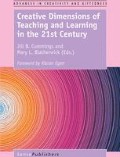Abstract
For many years, the education of children has been a standardized procedure by which teachers implement curriculum developed by governing bodies. Occasionally, allowances are made for learning styles and learning environments, however, across this diverse country many classrooms look the same. Dr. Kieran Egan, the director of the Imaginative Education Research group founded by Dr. Egan and the Faculty of Education at Simon Fraser University, has theorized that there is something missing in this form of educating.
Access this chapter
Tax calculation will be finalised at checkout
Purchases are for personal use only
Preview
Unable to display preview. Download preview PDF.
References
Alberta Education. (2005). Social studies kindergarten to grade 12. Retrieved from https://education.alberta.ca/media/159595/program-of-studies-gr-4.pdf
Ball, J. (2004). As if indigenous knowledge and communities mattered: Transformative education in first nations communities in Canada. American Indian Quarterly, 28(3/4), 454.
Egan, K. (2005). An imaginative approach to teaching. San Francisco, CA: Jossey-Bass – A Wiley Imprint.
Egan, K. (2008). Imaginative education. Retrieved from http://ierg.net/
Egan, K. (2008). The future of education: Reimagining our schools from the ground up. New Haven & London: Yale University Press.
Hare, J. (2012). “They Tell a Story and There’s Meaning behind That Story”: Indigenous knowledge and young indigenous children’s literacy learning. Journal of Early Childhood Literacy, 12(4), 389–414.
Ignas, V. (2004). Opening doors to the future: Applying local knowledge in curriculum development. Canadian Journal of Native Education, 28, 49–58.
Ornstein, A., & Hunkins, F. (2013). Curriculum: Foundations, principles and issues. Toronto: Pearson Publishing.
Strong-Wilson, T. (2008). Turtles all the way: Simulacra and resistance to Simulacra in indigenous teachers’ discussion of indigenous children’s literature. Children’s Literature in Education, 39(1), 53–74.
Wiggins, G. P., & McTighe, J. (2005). Understanding by design. Alexandria, VA: ASCD.
Author information
Authors and Affiliations
Editor information
Editors and Affiliations
Rights and permissions
Copyright information
© 2017 Sense Publishers
About this chapter
Cite this chapter
Jamieson, B. (2017). Imagining Alberta’s First Nations. In: Cummings, J.B., Blatherwick, M.L. (eds) Creative Dimensions of Teaching and Learning in the 21st Century. Advances in Creativity and Giftedness. SensePublishers, Rotterdam. https://doi.org/10.1007/978-94-6351-047-9_17
Download citation
DOI: https://doi.org/10.1007/978-94-6351-047-9_17
Publisher Name: SensePublishers, Rotterdam
Online ISBN: 978-94-6351-047-9
eBook Packages: EducationEducation (R0)

